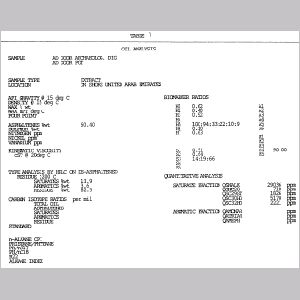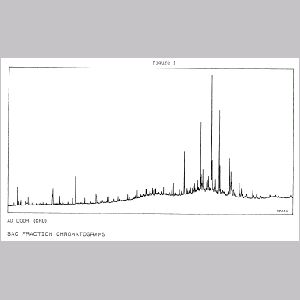Bulletin 38 July 1989: An Analysis of Bitumen from Ad Door
An Analysis of Bitumen from Ad Door
by R. L Wh i t eDuring the recent excavations at Ad-Door in Umm al Qaiwain a pot was uncovered which was sealed with bitumen. The pot was sent to the BP Research Laboratories at Sunbury for an investigation to determine the possible source of the bitumen. Below is a report from the Geochemistry Branch. For further details of the archaeology of Ad-Door, see P. Hellyer's article in Bulletin 34, pp.15-21. - Ed.
We were able to analyse the Ad-Door potsherd sample in the same manner as we would analyse crude/sediment extract samples. Firstly a small portion of bitumen was scraped off and dissolved in dichloromethane. The asphaltic material (complex polar organic compounds) was removed and the remaining sample then separated into saturates, aromatics and residues by high performance liquid chromatography. The saturates (alkanes) were analysed by gas chromatography. Both the saturates and the aromatic fractions were then analysed using GCMS, which enables the identification of biomarkers for source typing and direct "fingerprinting" for comparison with other oil samples. The data are presented in Table 1.
The SAC fraction gas chromatogram (Figure 1) shows a depletion in n-alkanes which is probably a result of biodegradation. It is not possible to determine whether this occurred after the pot was sealed or whether the bitumen was already degraded when used. However, the latter is quite likely as biodegradation occurs at or near the surface by aerobic bacteria and is usually associated with seeping petroleum. The aromatics GCr1S analysis gave no meaningful data.
The molecular parameters, from saturates GCMS analysis (Figure 2) display a high hopane/sterane ratio (M4) and a marked abundance of C29 steranes relative to the C27 steranes (S3). This would normally suggest terrestrial input but in this case it appears that the C29 steranes were derived from cyanobacteria. The same pattern has been seen in "ancient oils", ie those derived from early Palaeozoic source rocks.
Despite our database, no other oils of this type are known to us from Iraq, while we have no biomarker analysis of Iranian oils. The only Middle Eastern oil considered to be of a similar age is a sample from an Omani well analysed in 1979. This particular sample is believed to be from a Cambrian shale and shows some similarities to the results obtained from the Ad-Door pot. In summary, we believe the bitumen to have been generated hy an early Palaeozoic source, probably collected from a biodegraded oil seep. 20th April, 1989
Geochemical studies in Iran have confirmed an exclusive Palaeozoic source for hydrocarbons in both Fars and Khuzestan Provinces. Substantial bitumen seeps occur in both regions. It is not unreasonable to speculate that the Ad-Door bitumen sample may have come from the hinterland of Bandarabbas, which lies one day's sail away on the opposite side of the Gulf. - Ed.


